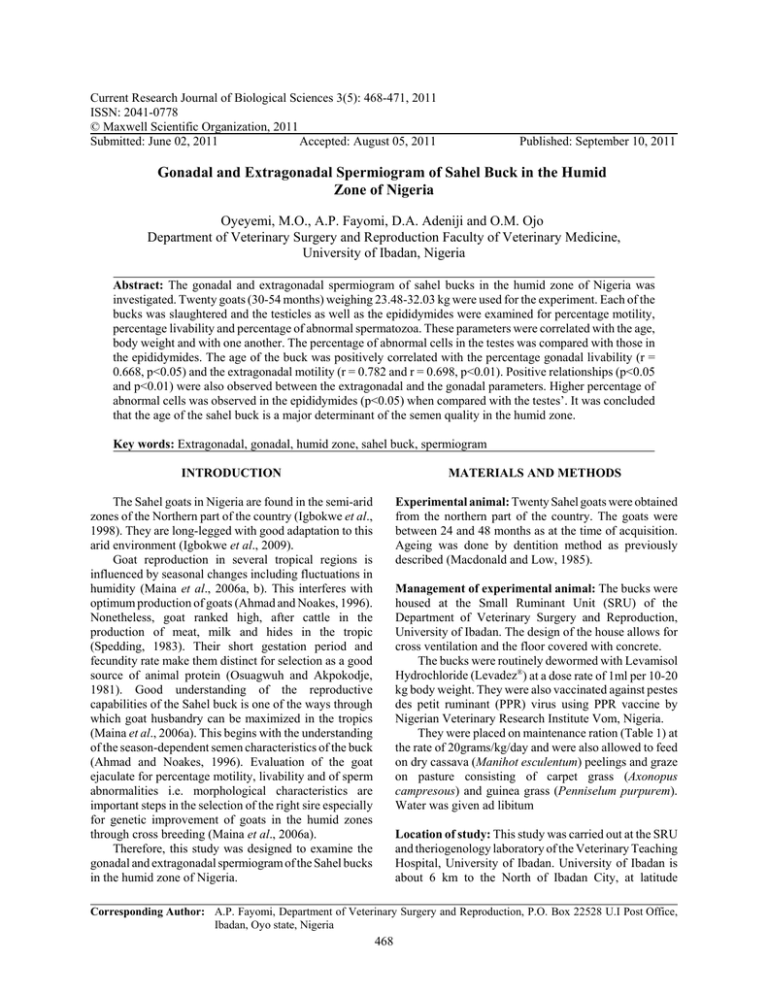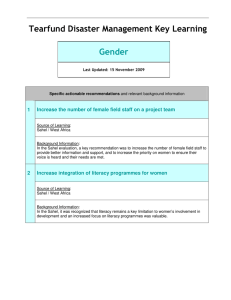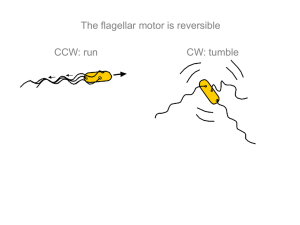Current Research Journal of Biological Sciences 3(5): 468-471, 2011 ISSN: 2041-0778
advertisement

Current Research Journal of Biological Sciences 3(5): 468-471, 2011 ISSN: 2041-0778 © Maxwell Scientific Organization, 2011 Submitted: June 02, 2011 Accepted: August 05, 2011 Published: September 10, 2011 Gonadal and Extragonadal Spermiogram of Sahel Buck in the Humid Zone of Nigeria Oyeyemi, M.O., A.P. Fayomi, D.A. Adeniji and O.M. Ojo Department of Veterinary Surgery and Reproduction Faculty of Veterinary Medicine, University of Ibadan, Nigeria Abstract: The gonadal and extragonadal spermiogram of sahel bucks in the humid zone of Nigeria was investigated. Twenty goats (30-54 months) weighing 23.48-32.03 kg were used for the experiment. Each of the bucks was slaughtered and the testicles as well as the epididymides were examined for percentage motility, percentage livability and percentage of abnormal spermatozoa. These parameters were correlated with the age, body weight and with one another. The percentage of abnormal cells in the testes was compared with those in the epididymides. The age of the buck was positively correlated with the percentage gonadal livability (r = 0.668, p<0.05) and the extragonadal motility (r = 0.782 and r = 0.698, p<0.01). Positive relationships (p<0.05 and p<0.01) were also observed between the extragonadal and the gonadal parameters. Higher percentage of abnormal cells was observed in the epididymides (p<0.05) when compared with the testes’. It was concluded that the age of the sahel buck is a major determinant of the semen quality in the humid zone. Key words: Extragonadal, gonadal, humid zone, sahel buck, spermiogram INTRODUCTION MATERIALS AND METHODS The Sahel goats in Nigeria are found in the semi-arid zones of the Northern part of the country (Igbokwe et al., 1998). They are long-legged with good adaptation to this arid environment (Igbokwe et al., 2009). Goat reproduction in several tropical regions is influenced by seasonal changes including fluctuations in humidity (Maina et al., 2006a, b). This interferes with optimum production of goats (Ahmad and Noakes, 1996). Nonetheless, goat ranked high, after cattle in the production of meat, milk and hides in the tropic (Spedding, 1983). Their short gestation period and fecundity rate make them distinct for selection as a good source of animal protein (Osuagwuh and Akpokodje, 1981). Good understanding of the reproductive capabilities of the Sahel buck is one of the ways through which goat husbandry can be maximized in the tropics (Maina et al., 2006a). This begins with the understanding of the season-dependent semen characteristics of the buck (Ahmad and Noakes, 1996). Evaluation of the goat ejaculate for percentage motility, livability and of sperm abnormalities i.e. morphological characteristics are important steps in the selection of the right sire especially for genetic improvement of goats in the humid zones through cross breeding (Maina et al., 2006a). Therefore, this study was designed to examine the gonadal and extragonadal spermiogram of the Sahel bucks in the humid zone of Nigeria. Experimental animal: Twenty Sahel goats were obtained from the northern part of the country. The goats were between 24 and 48 months as at the time of acquisition. Ageing was done by dentition method as previously described (Macdonald and Low, 1985). Management of experimental animal: The bucks were housed at the Small Ruminant Unit (SRU) of the Department of Veterinary Surgery and Reproduction, University of Ibadan. The design of the house allows for cross ventilation and the floor covered with concrete. The bucks were routinely dewormed with Levamisol Hydrochloride (Levadez®) at a dose rate of 1ml per 10-20 kg body weight. They were also vaccinated against pestes des petit ruminant (PPR) virus using PPR vaccine by Nigerian Veterinary Research Institute Vom, Nigeria. They were placed on maintenance ration (Table 1) at the rate of 20grams/kg/day and were also allowed to feed on dry cassava (Manihot esculentum) peelings and graze on pasture consisting of carpet grass (Axonopus campresous) and guinea grass (Penniselum purpurem). Water was given ad libitum Location of study: This study was carried out at the SRU and theriogenology laboratory of the Veterinary Teaching Hospital, University of Ibadan. University of Ibadan is about 6 km to the North of Ibadan City, at latitude Corresponding Author: A.P. Fayomi, Department of Veterinary Surgery and Reproduction, P.O. Box 22528 U.I Post Office, Ibadan, Oyo state, Nigeria 468 Curr. Res. J. Biol. Sci., 3(5): 468-471, 2011 Table 1: Composition and of the ration Ingredient Corn Meal Wheat Offal Palm Kernel Cake Brewer’s Dry Grain Groundnut Cake Salt Minerals/Premix Table 2: Proximate analysis of the ration Chemical composition Proportion of constituents Crude protein 3.86% Fat 6.16% Crude fiber 10.6% Ash 13.42% Moisture content 2.69% Energy 2271.45 cal/kg Oyeyemi and Akusu (2002) Percentage of component 20 20 16 40 3.5 0.4 0.1 Table 3: Physical parameters of sahel bucks in the humid zone Age (Month) 43.38±10.44 Body Weight (kg)13.23±1.69 2nd longitude 3º54! East at mean altitude of 277 m above sea level. The annual rainfall is 1,200 mm, 7º26! North and longitude 3º54! East at mean altitude of 277 m above sea level. The annual rainfall is 1,200 mm, most of which fall between April and November, and a dry season from December to March (Oyeyemi and Fayomi, 2011). This study was carried out between April and October, 2010 under the same ambient temperature (27-31ºC) and relative humidity of about 80%. the relationship between them. These were done at 95% confidence interval and they were considered significant when p<0.05. RESULTS The values of the mean±standard deviation of each of the parameters are presented in Table 2-5. Experimental design: The bucks were fed and housed for six months until they were 30-54 months old and weighed between 23.48-32.03 kg. The live weight of the bucks was measured at about 0800 hours (not less than 12 h after exposure to the last feed). The bucks were slaughtered and the testes and epididymides were collected as previously described (Kabiraj et al., 2011). Right testis: The Age of the Sahel buck is positively correlated to the gonadal percentage livability (r = 0.668, p<0.05) and extragonadal Percentage motility (r = 0.782, p<0.01). The gonadal percentage motility is positively correlated with the extragondal percentage motility (r = 0.787, p<0.05) and the extragonadal percentage livability (r = 0.658, p<0.05) (Table 6). Data collection: The testes with the epididymides were immediately collected and kept in a water bath maintained at 32ºC. Drops of sperm were collected from the caudal epididymides and the testicles following incisions into the parenchyma of these organs. Left testis: The age of the buck is also positively correlated with the extragonadal percentage motility (r = 0.698 p<0.01) (Table 6). The gonadal percentage motility is positively correlated (r = 0.845, p<0.01) with the extragonadal percentage motility while the percentage livability is positively correlated with the extragonadal percentage livability (r = 0.585, p<0.05) (Table 6). There is no significant difference (p>0.05) between the values of the percentage motility and livability from the right testis and epididymis when compared with the left’s. However, the percentage of the rudimentary tail, curved tail, and coiled tail abnormalities were higher (p<0.05) in the right epididymis than in the right testis while the percentage of the rudimentary tail, bent tail and coiled tail abnormalities were also higher (p<0.01) in the left epididymis than in the left testis. Sperm evaluation: Motility: Semen sample was collected with a warm slide. This was mixed with warm 2.9% sodium citrate solution (as buffer), covered with cover slip and examined under the microscope as previously described (Zemjanis, 1977) Livability: Smear was prepared from the collected epididymal and testicular samples and stained with Eosin and Nigrosin stain. This was followed immediately by examination under the microscope as previously described (Zemjanis, 1977). Morphological characteristics: Smear was also prepared from the collected sperm cells and stained with Wells and Awa stain. Evaluation under the microscope as previously described by Zemjanis (1977) was then carried out. DISCUSSION Data analysis: The means and the standard deviation of each of the parameters studied were determined. Independent sample t-test was used to compare the parameters of the right with the left’s. Also, multiple correlation of each of the parameters of the right and the left testes and epididymides were performed to establish The positive relationship between the age of the buck and the extragonadal motility was a consistent finding in the right and left testes which is similar to previous reports (Hassan et al., 2009; Maina et al., 2006a). The relationship observed with the extragonadal motility is a direct consequence of the influence of the gonads as 469 Curr. Res. J. Biol. Sci., 3(5): 468-471, 2011 Table 4: Motility and livability of the sahel buck in humid zone Right Gonadal Motility (%) 26.15±19.38 Extragonadal Motility (%) 75.00±20.21 Gonadal Livability (%) 90.08±5.79 Extragonadal Livability(%) 95.77±2.28 Left 27.69±19.22 73.46±20.55 88.77±8.02 95.15±2.67 Average 26.92±18.92 74.23±19.98 89.42±6.89 95.46±2.45 Table 5: Morphological characteristics of the sahel buck in humid zone (percentage of abnormal sperm cells) Right Left ------------------------------------------------------------------------------------------------------------------------------Testis Epididymis Testis Epididymis Tailless Head 2.23±1.71 3.15 ±1.95 1.62±0.47 3.00 ±1.65 Headless Fail 5.23±3.29 9.00 ±3.20 4.69±3.66 8.69 ±5.82 Rudimentary Tail 9.54±3.09* 14.38±4.48* 7.46±2.82* 12.46±4.45* Bent Tail 3.54±1.76 5.00 ±2.20 2.08±1.75* 5.00 ±2.42* Curved Tail 4.46±1.66* 6.62 ±3.01* 4.69±2.43 6.77 ±3.49 Best Mid-Piece 1.15±0.90 1.92 ±0.33 1.00±0.71 1.62 ±1.15 Curved Mid-Piece 0.46±0.38 0.46 ±0.36 0.46±0.31 0.77 ±0.34 Looped Tail 0.00±0.00 0.85 ±0.48 0.15±0.08 0.77 ±0.36 Coiled Tail 29.85±16.07** 49.38±16.86** 25.00±14.51* 46.23±18.62* *: Values are significantly different (p<0.05); **: Values are significantly different (p<0.01) Table 6: Correlation coefficient of the parameters and their significances Age (Months) Gonadal Motility Extragonadal Motility Gonadal Livability -------------------------------------------- --------------------------- -------------------------Right left Right left Right left Right left Age(Months) 0.782** 0.698** 0.668* Gonadal Motility 0.787** 0.854** Extragonadal Motility 0.782** 0.698** 0.787** 0.854** Gonadal Livability 0.668* Extragonadal Livability 0.658* 0.585* *: Values are significantly correlated (p< 0.05); **: Values are significantly correlated (P< 0.01) positive relationship exists between the gonadal motility and the extragonadal motility. Age appears to be an important factor that determines the percentage motility of the sahel bucks in the humid zone. Moreover, the positive relationship between the age of the buck and the gonadal livability which in turns determines the percentage of the extragonadal livability and the relationship of the latter with the gonadal motility corroborate the role of age in the determination of the quality of semen produce by the sahel buck in the humid zone. However, certain spermatozoa defects namely rudimentary tail, coiled tail, curved tail and bent tail abnormalities were observed to increase during the epididymal transit. This is also similar to previous report and the influence of season on scrotal thermoregulation during the spermatozoa storage in the epididymis has been incriminated (Maina et al., 2006b). Further studies directed towards investigating the mechanism behind this in the sahel buck are recommended. It can be concluded that age is an important factor in the determination of the quality of semen production by the sahel bucks in the humid zone. Extragonadal Livability ----------------------------Right left 0.658* 0.585* REFERENCES Ahmad, N. and D.E. Noakes, 1996. Seasonal variation in the semen quality of young british goats. Br. Vet. J., 152: 225-236, Hassan, M.R., S. Pervage, M. Ershaduzzaman and M.A.I. Talukder, 2009. Influence of age on the spermiogramic parameters of native sheep. J. Bangladesh Agril. Univ., 7(2): 301-304. Igbokwe, I.O., H.A. Grema, A.E. Ikpo, F.M. Mshelbwala and N.A. Igbokwe, 2009. Unilateral cryptorchidism in Nigerian Sahel bucks. Int. J. Morphol., 27(3): 805810. Igbokwe, I.O., A.Y. Ribadu and M.M. Bukar, 1998. Erythrocyte glutathione concentrations in Nigerian Sahel goats. Small Ruminant Res., 30: 1-6. Kabiraj, S.K., S.A. Masusul Hoque, M.A.M. Yahia Khandoker and S.S. Husain, 2011. Testicular biometry and its relationship with body weight and semen output of black Bengal bucks in Bangladesh. J. Cell. Animal Biol., 5(2): 27-32. Macdonald, I.and J. Low, 1985. Livestocks Rearing in the Tropics. Macmillian Education Ltd., London, pp: 63. Maina, V.A., S.U.R. Chaudhari and G.D. Mshelia, 2006a. Spermiogram of white ecotype of sahel bucks in Maiduguri Metropolis. Pak. J. Biol. Sci., 9(2): 307-309. ACKNOWLEDGMENT We want to appreciate the duo of Mr O. O. Ogundijo and Mr Ejiro Omoko of the Theriogenology Laboratory in the Department of Veterinary Surgery and Reproduction, University of Ibadan, Nigeria for their technical assistant. 470 Curr. Res. J. Biol. Sci., 3(5): 468-471, 2011 Oyeyemi, M.O. and A.P. Fayomi, 2011. Gonadosomatic Index and Spermatozoa Morphological characteristics of Male Wistar rat treated with graded concentration saof Aloe vera gel. Inter. Joun Anim. Veteri. Adv., 3(2): 47-53. Spedding, C.R.W., 1983. Sheep and goat production. J. Liv. Prod. Sci., 10: 93. Zemjanis, R., 1977. Collection and Evaluation of Semen. Diagnostic and Therapeutic Technique in Animal Reproduction. 3rd Edn., The Williams and Wilkins company, Baltimore, pp: 139-180. Maina, V.A., S.U.R. Chaudhari, G.D. Mshelia and A. Williams, 2006b. Influence of season on semen characteristics of sahel bucks in Borno state. J. Appl. Sci., 6(2): 353-358. Osuagwuh, A.I.A. and I.U. Akpokodje, 1981. The West African Dwarf (Fouta Djallon) goat I: Causes of Early Mortality. Intl. goat sheep Res., 1: 303-309. Oyeyemi, M.O., M.O. Akusu, 2002. Response of multiparous and primiparous West African Dwarf goats (Capra hircus, L.) to concentrate supplementation. Vet. Arhiv., 72: 29-38. 471





